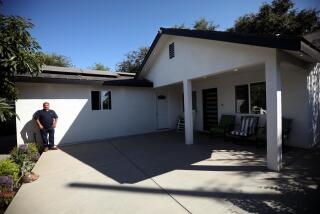With Grid-Pattern Projects in Again, It May Be a Dead End for Cul-De-Sacs
- Share via
MASON, Ohio — Jenny and Rick White enjoy living on their cozy cul-de-sac, where traffic is light and neighbors are friendly.
“There are a lot of advantages,” she said. “It’s safer for kids because people don’t drive as fast and we know everyone who lives on this street.”
People cherish the privacy and peace of mind that they get from living on suburban dead-end streets. Children can ride their bicycles without worrying about heavy traffic. Usually, the people driving by belong here and often meet for parties or barbecues.
Because so few vehicles travel streets with no outlet, residents say they are free from noise and heavy exhaust fumes.
But the oasis creates traffic gridlock for others, elsewhere, transportation experts say. And that is one reason planners are starting to return to traditional developments reminiscent of neighborhoods in the early 1900s: smaller lots on straight streets in a grid pattern.
Steven Bodzin, spokesman for San Francisco-based Congress for the New Urbanism, said there are about 250 grid-pattern developments throughout the country, with hundreds more being planned.
“We see a higher level of devotion to the towns and a better sense of community,” he said. “I think people are missing that in conventional suburbia.”
Planners say dead-end streets, which sometimes don’t have sidewalks, can also discourage social interaction, isolating residents.
“Virtually every trip involves getting in the car, even to get a gallon of milk or a loaf of bread,” said Greg Dale, a Cincinnati-based urban planning consultant who has worked with communities nationwide. “People used to be able to walk to the corner store. Too many cul-de-sacs can create isolation between neighborhoods. There’s a sense of community that’s lost.”
Ninety-five percent of 120 subdivisions being built outside Cincinnati in Warren County, where the Whites live, include cul-de-sacs. The area, once more rural than suburban, is fast becoming densely developed and populated.
Roger Young, with his wife and three daughters, settled on one of the dead-end streets two years ago. Safety was a major reason.
“There’s a lot of trust between neighbors, a real neighborhood feeling,” he said. “We have Fourth of July parties and block parties in the summer. If you’re teaching your kids to ride their bikes or sending them out to play, you don’t worry at all.”
But county engineer Neil Tunison said the few main streets serving these subdivisions often become clogged with traffic and can create safety problems.
Bodzin said the neighborhoods also discourage racial and economic diversity. “In these developments, you usually have one culture, people of the same economic class,” he said. “Studies have shown they have less interest in their community and belong to fewer social clubs. Everyone tends to do their own thing instead.”
French for “bottom of a sack,” the cul-de-sac has been around for hundreds of years but did not become popular in the United States until the mid-1950s.
Radburn, N.J., was one of the first cities to use no-outlet streets, said Jeff Spech, an urban planner and co-author of the book “Suburban Nation.” “The idea was to separate cars from pedestrians,” he said. “Developers saw that people liked them, so they started building whole developments of them.”
Bodzin said the new movement of returning to grid-patterned communities started with Seaside, a 1981 development near Panama City, Fla. Seaside has a town green and retail shops within walking distance of homes.
Developers throughout the country have followed suit. Change has been slower in Midwestern communities with few new developments, Bodzin said.
But other developers say families still find cul-de-sacs desirable. Jim Obert, planning director for Great Traditions Land & Development Co. in Cincinnati, said developers get higher prices for homes and lots on dead-end streets.
The Whites, who have a son in high school and daughter in middle school, say there are some drawbacks to living on a cul-de-sac.
“In the winter, we’re about the last street to get the snow cleared,” Jenny White said.
More to Read
Sign up for Essential California
The most important California stories and recommendations in your inbox every morning.
You may occasionally receive promotional content from the Los Angeles Times.













